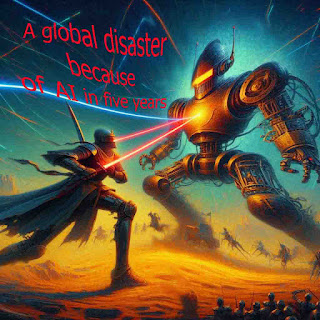Attempt to connect painting, collage and digital
My creation process consists of superimposing different images using algorithms close to the AI that create a recomposition strategy as human memory could do. Human memory does not operate like a camera, it distorts, confuses, agglomerates, mixes and deforms. It is for me to go beyond the automations of the AI to find a new vision through a process of emergence. This consists in observing how photographic shooting, image fusion algorithms bring back to art.
samedi 3 février 2024
mercredi 31 janvier 2024
New version robot
Robot heads symbolize digital hardware and programming. The eyes of robot characters mimic real life. In the digital world very often pushing the limits is to create new versions of what has already been done by improving them. See the various versions of photshop or Windows. Each new version pushes the boundaries.
Study of Robot heads metaphor of a new digital version. A new robot head emerges, a new version .. The other robots seem surprised by this emergence of a new version.
lundi 4 décembre 2023
samedi 25 novembre 2023
vendredi 10 novembre 2023
dimanche 29 octobre 2023
Meeting between two different artificial intelligences
vendredi 13 octobre 2023
Animation Spiritual art and robot with NFT
The links between the world of art and computing have multiplied and become more complex. It finds its foundations, its structures its tensions in the two worlds of origin: that of art and that of computer science.
lundi 9 octobre 2023
Animation Battle of robot
Collection Battle of robots .Battle of robots One of the uses of robots is surely to fight each other. Right now the drone war has begun in Russia and Ukraine.
vendredi 22 septembre 2023
Battle of robots Triptyque
Behind computers there are always men but now more and more methodically helped by methodical artificial intelligences. They will encounter other artificial intelligences trying to destroy them.
This is the struggle of the machines interviewed by Georges Bernanos in 1947 La France Contre les Robots. Struggles that fictional science has developed in epic novels like the author Asimov.
The imagery presented is a metaphor of these struggles.
It is made from an AI that shows its own aggressiveness towards other machines from images searched in the network.
jeudi 14 septembre 2023
lundi 4 septembre 2023
Battle of robot
samedi 2 septembre 2023
Robots watching us?
Robots, in the traditional sense, do not watch us with intent or consciousness as humans do. Robots are machines programmed to perform specific tasks or functions, often in a controlled and pre-determined manner. They lack the ability to observe or make sense of the world in the way humans do.
However, there are various types of technology and devices equipped with sensors and cameras that can capture images and data from their surroundings. These devices are often used for surveillance, monitoring, or data collection purposes. Examples include security cameras, drones, and even some autonomous vehicles. In these cases, it is not the robots themselves that are watching us, but rather the technology they are equipped with that can be used for monitoring and observation.
It's essential to distinguish between the capabilities and intentions of machines and the use of technology for specific purposes. While technology can capture data and images, it does so as part of a programmed or designed function, without consciousness or intent. Concerns related to privacy and surveillance often arise from how these technologies are used and the policies and regulations governing their use.
Fluidity of images
The concept of fluidity in art can encompass various aspects and interpretations, depending on the context and the specific medium in which it is applied. Here are a few perspectives on the fluidity of images in art:
Visual Fluidity: Visual fluidity often refers to the smoothness and continuity of visual elements within an artwork. This can relate to how lines, shapes, colors, and textures interact to create a sense of flow and movement in the composition. Artists can use techniques such as blending, gradients, and brushwork to achieve visual fluidity, which can enhance the overall aesthetic and impact of the artwork.
Narrative Fluidity: In narrative or storytelling art forms, such as literature, film, or sequential art (comics and graphic novels), fluidity can refer to the seamless progression of the story or narrative elements. A well-executed narrative should transition smoothly from one scene or event to another, maintaining the audience's engagement and comprehension.
Conceptual Fluidity: Some contemporary art challenges traditional notions of fixed images and embraces fluidity in the conceptual sense. Artists may use multimedia, interactive installations, or performance art to explore how images and ideas can change, evolve, or adapt over time. This challenges viewers to engage with art in a dynamic and evolving manner.
Psychological and Emotional Fluidity: Art has the power to evoke emotions and engage the viewer's mind. The fluidity of images can be seen as a metaphor for the fluidity of human emotions and thoughts. Art that captures the complexity and ever-changing nature of the human experience can be considered highly expressive and thought-provoking.
Cultural and Historical Fluidity: Art has the ability to transcend cultural and historical boundaries. It can incorporate diverse influences and styles, leading to a fluid blending of different artistic traditions and perspectives. This cultural and historical fluidity can result in rich, hybrid forms of art that reflect a globalized world.
Perception and Interpretation: The way viewers perceive and interpret art can also be fluid. Different people may see different things in the same artwork or find their understanding of it changing over time. This variability in interpretation adds depth and richness to the art experience.
Ultimately, the fluidity of images in art can be a powerful tool for artists to convey their ideas, challenge conventions, and engage viewers on multiple levels. It allows for creativity, experimentation, and the exploration of diverse themes and concepts, making it a fundamental aspect of the ever-evolving world of art.

















